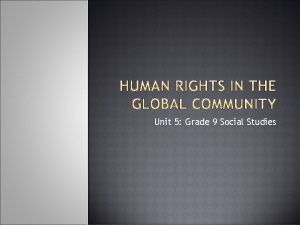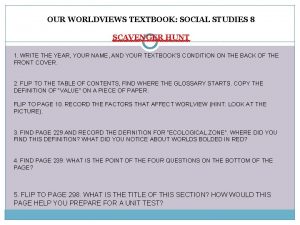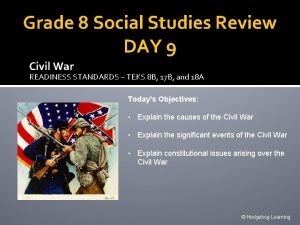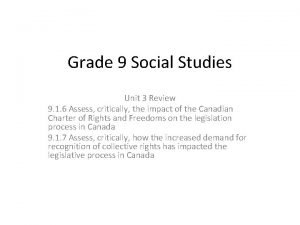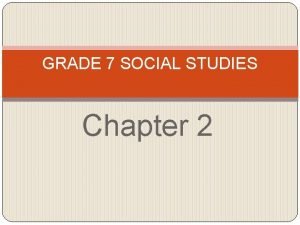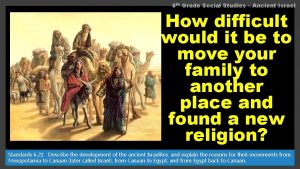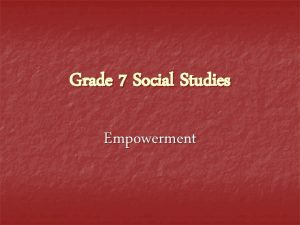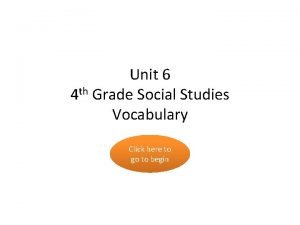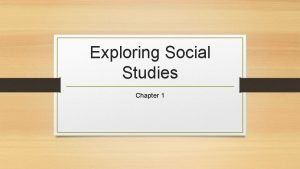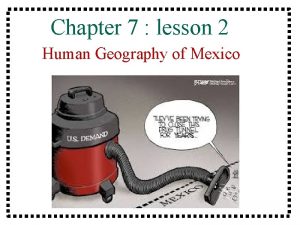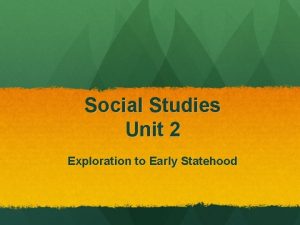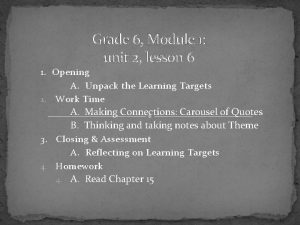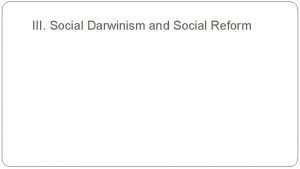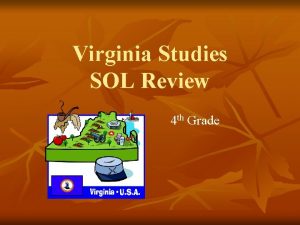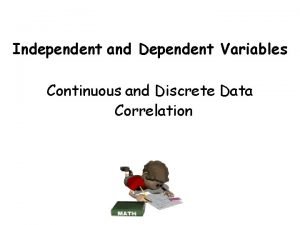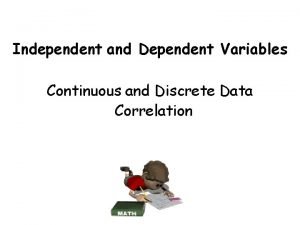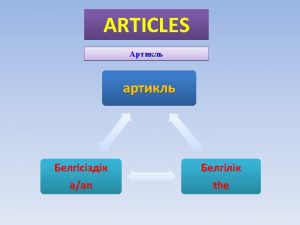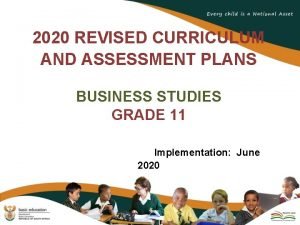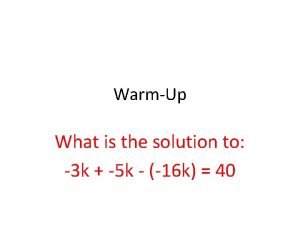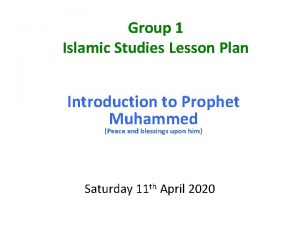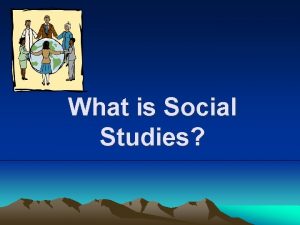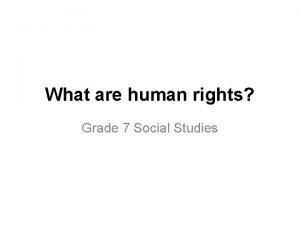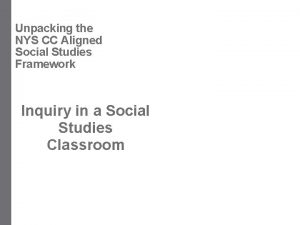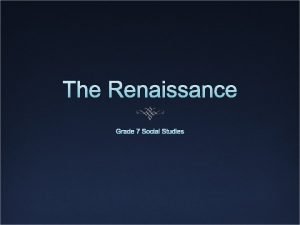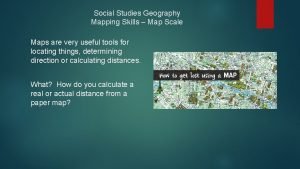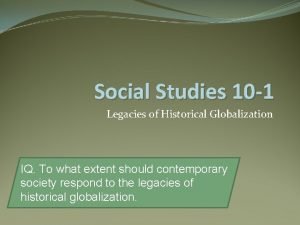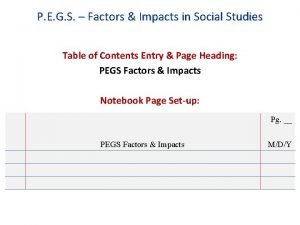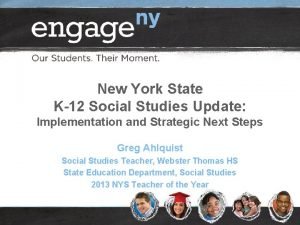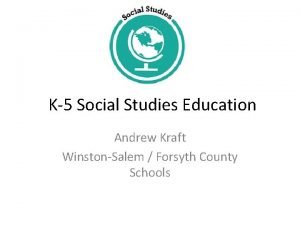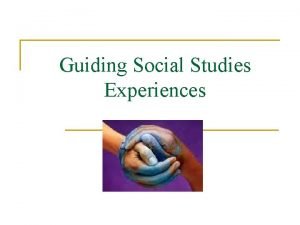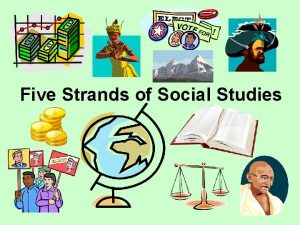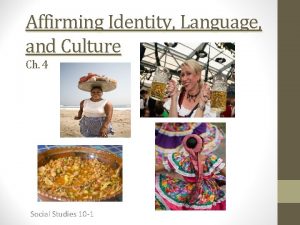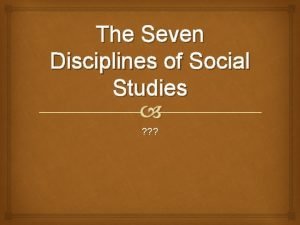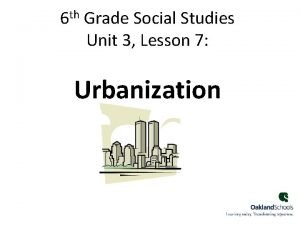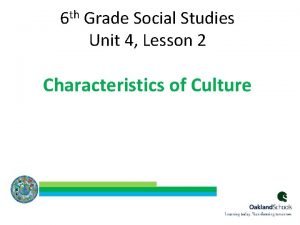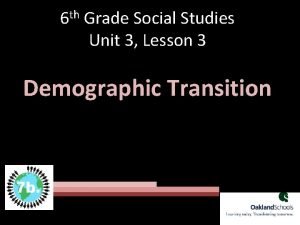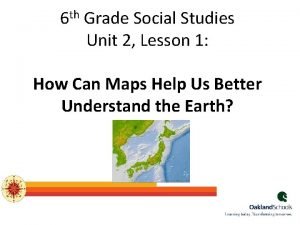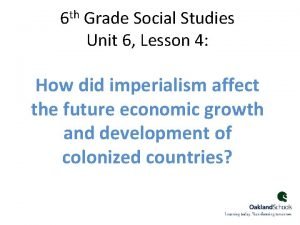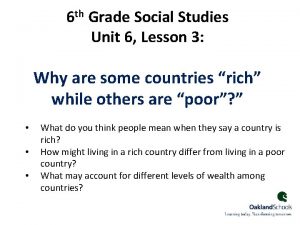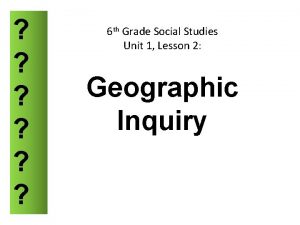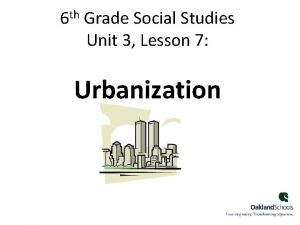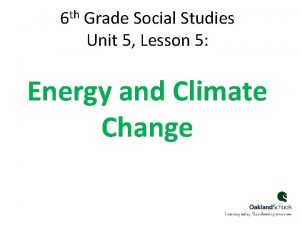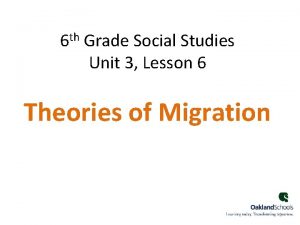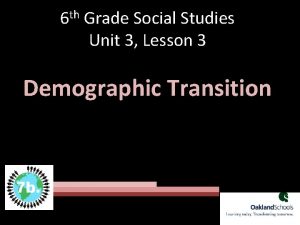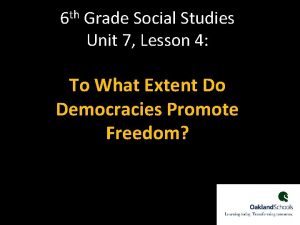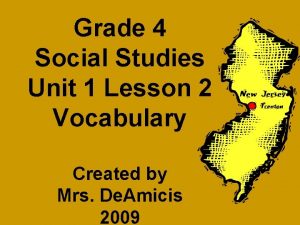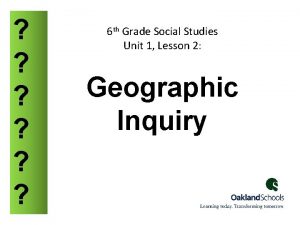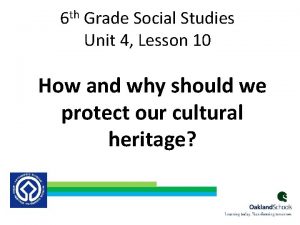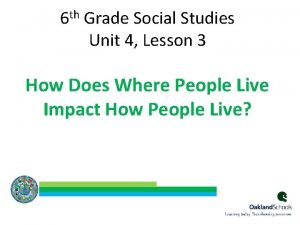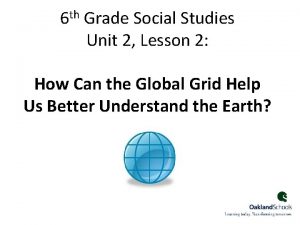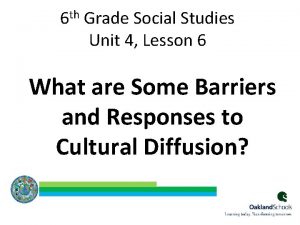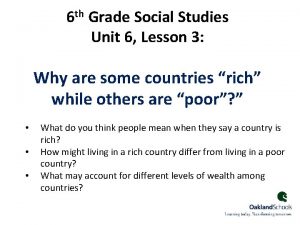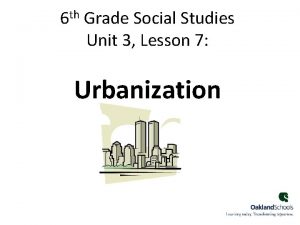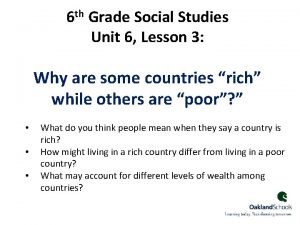th 6 Grade Social Studies Unit 6 Lesson













































- Slides: 45

th 6 Grade Social Studies Unit 6, Lesson 1: What is Economics? 1

Every society has RESOURCES.

Every society has RESOURCES. NATURAL (Land) RESOURCES HUMAN (Labor) RESOURCES CAPITAL RESOURCES

Every society has RESOURCES NATURAL (Land) RESOURCES HUMAN (Labor) RESOURCES which are used to produce GOODS and SERVICES CAPITAL RESOURCES

But RESOURCES are limited and HUMAN WANTS are unlimited which results in

But RESOURCES are limited and HUMAN WANTS are unlimited which results in SCARCITY

SCARCITY forces societies to make

SCARCITY forces societies to make CHOICES in order to answer

SCARCITY forces societies to make CHOICES in order to answer the questions: WHAT goods and services will be produced? HOW will the goods and services be produced? WHO will consume the goods and services?

SCARCITY forces societies to make CHOICES in order to answer the questions: WHAT goods and services will be produced? HOW will the goods and services be produced? WHO will consume the goods and services? How a society answers these questions will result in a particular type of ECONOMIC SYSTEM

11

Economists study ? … how people produce, distribute, and consume goods and services This includes: • Scarcity, choice, and decision making • Different kinds of economic systems • Productive resources (natural, human, capital) • Specialization, trade, and interdependence 12

Effects of Natural Disasters 13

Economic Effects of Natural Disasters? ? ? 14

Economic Effects of Natural Disasters • Disruption of the economy • Loss of jobs due to damage of buildings, etc. • Physical damage to businesses and industry • Loss of businesses • Disruptions in trade 15

Migration 16

Push/Pull Factors 17

Push/Pull Factors What is an example of an economic push factor? 18

Push/Pull Factors What is an example of an economic push factor? What is an example of an economic pull factor? 19

20

From 1955 until 1973, over one million guest workers arrived in the Federal Republic of Germany, mostly from Italy, Spain, and Turkey. Many people from Mexico and other Latin American countries migrate to the United States looking for jobs and a better life. The State of Qatar has one of the fastest growing economies in the world and a relatively small native population. This situation has led to an influx of foreign nationals and a population boom. 21

Migration Urbanization Causes Effects 22

What are some economic reasons that people move to cities? 23

What are some economic reasons that people move to cities? • Jobs • More opportunities • A chance for a better life • A greater variety of goods 24

CULTURE Cultural Components Relating to Economics 25

CULTURE Cultural Components Relating to Economics · · The ways people make a living They types of currency people use The ways in which goods are made People’s beliefs about wealth and material goods 26

Cultural Landscapes 27

How do Cultural Landscapes Reflect Economics? 28

Using the Environment Human/ Environment Interaction Adapting to the Environment Modifying the Environment 29

Photographs of the Aral Sea 2000 2012 30

Photographs of the Aral Sea 2000 2012 How did economics relate to the shrinking of the Aral Sea? Source: Photographs of the Aral Sea. http: //meridian. aag. org/changingplanet/index. cfm? action=main. module§ion. ID=1&module. ID=4&page. ID=18 31

What were some economic effects of the shrinking of the Aral Sea? 32

What are they? Where are they? NATURAL RESOURCES How do people use them? 33

ACTIVITY 34

What did you learn about economics in this activity? Letter A B C D Natural Resources cobalt, copper, niobium, tantalum, petroleum, industrial and gem diamonds, gold, silver, zinc, manganese, tin, uranium, coal, hydropower, timber deepwater harbor, feldspar Rich, Poor or In the Middle? Dem. Rep of the Congo Hong Kong nickel, uranium, rare earth oxides, peat, cobalt, copper, platinum, vanadium, arable land, hydropower, niobium, tantalum, gold, tin, tungsten, kaolin, limestone petroleum, natural gas, fish E coal, copper, lead, molybdenum, phosphates, rare earth elements, uranium, bauxite, gold, iron, mercury, nickel, potash, silver, tungsten, zinc, petroleum, natural gas, timber F none G hydropower, fertile agricultural land, gold, diamonds, petroleum, hardwoods, limestone, iron ore, copper, chromium ore, zinc, tungsten, mica, silver H limestone, arable land, hydropower, unexploited deposits of uranium, coal, and bauxite RICH Burundi Quatar United States Macao South Sudan Malawi POOR 35

Human Modification Of the Environment 36

Human Modification Of the Environment What are some economic reasons humans modify the environment? 37

38

39

40

41

42

Economic Globalization is about connections and interdependence 43

Criteria/ Definition of Economic Globalization • The development of increased interconnections and interdependence • of many different economic systems • marked by free trade and the free flow of capital, labor, and resources 44

Property of Oakland Schools Author: Carol Egbo Editor: Amy Bloom Copyright © 2010 -2015 Oakland Schools 45
 Meaning of living together in social studies
Meaning of living together in social studies History grade 9 unit 5
History grade 9 unit 5 Elements of worldview grade 8
Elements of worldview grade 8 Day 9 grade 8 social studies staar review
Day 9 grade 8 social studies staar review Social 9 chapter 3 test
Social 9 chapter 3 test Social studies chapter 2
Social studies chapter 2 6th grade social studies ancient israelites
6th grade social studies ancient israelites Grade 7 social studies empowerment
Grade 7 social studies empowerment 8th grade social studies
8th grade social studies 4th grade social studies vocabulary
4th grade social studies vocabulary Exploring social studies lesson 1 thinking like a historian
Exploring social studies lesson 1 thinking like a historian Chapter 7 lesson 2 social studies
Chapter 7 lesson 2 social studies Social studies unit 2 test answers
Social studies unit 2 test answers Paradigm shift from women studies to gender studies
Paradigm shift from women studies to gender studies Unit 2 lesson 6
Unit 2 lesson 6 What was reform darwinism?
What was reform darwinism? Apa itu social thinking
Apa itu social thinking Social thinking social influence social relations
Social thinking social influence social relations Right triangle trigonometry
Right triangle trigonometry Virginia studies 4th grade
Virginia studies 4th grade Continuous data
Continuous data A student's grade depends on how much she studies
A student's grade depends on how much she studies He studies english
He studies english 2020 revised curriculum and assessment plans
2020 revised curriculum and assessment plans A student's grade depends on how much she studies
A student's grade depends on how much she studies Unit 6 review questions
Unit 6 review questions Islamic studies lesson plan samples
Islamic studies lesson plan samples Social studies alphabet
Social studies alphabet Human rights grade 7
Human rights grade 7 Nys standards social studies
Nys standards social studies Renaissance definition social studies
Renaissance definition social studies Social studies notebook cover
Social studies notebook cover Map scale formula
Map scale formula Grand exchange social
Grand exchange social Tradisi citizenship transmission adalah
Tradisi citizenship transmission adalah Pegs definition social studies
Pegs definition social studies Nys social studies toolkit
Nys social studies toolkit Kas standards
Kas standards Winston salem forsyth county schools social studies
Winston salem forsyth county schools social studies What is social studies and why is it important
What is social studies and why is it important Brain wrinkles social studies answer key
Brain wrinkles social studies answer key 5 strands of social studies
5 strands of social studies Social studies essay
Social studies essay Affirmation of identity social studies
Affirmation of identity social studies 7 disciplines of social science
7 disciplines of social science Social studies terminology
Social studies terminology

